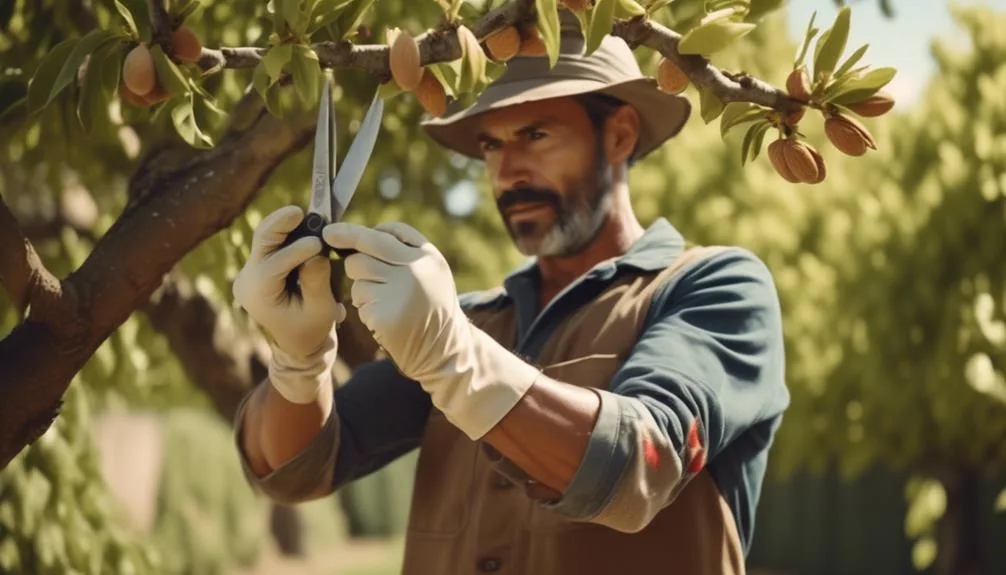Growing your own almond trees can be a rewarding experience. From planting to harvesting, there's a lot to learn about almond tree care. Whether you're new to gardening or have a green thumb, this guide will give you the essential tips to help your almond trees thrive.
Get ready to discover all you need to know to turn your backyard into a flourishing almond orchard.
Key Takeaways
- Choosing the right location is crucial for the successful growth of almond trees, with well-draining soil and full sun exposure being important factors.
- Proper watering and fertilizing techniques are essential, including regular watering, deep but infrequent irrigation, and conducting soil tests to determine nutrient needs and applying a balanced fertilizer.
- Pruning and training the trees in winter, creating an open center, and guiding new growth in summer are important for maintaining a balanced branch structure, allowing sunlight and air to reach all parts of the tree, and promoting an open canopy for even fruiting.
- Implementing integrated pest and disease management strategies, including using cultural, biological, and chemical control methods, encouraging natural predators, selecting disease-resistant varieties, and regularly monitoring and managing pests and diseases, is crucial for maintaining tree health and productivity.
Planting Almond Trees
When planting almond trees, it's important to choose a location with well-draining soil and full sun exposure to ensure their successful growth. Almond trees thrive in well-draining soil, so be sure to pick a spot where water won't pool around the roots.
Additionally, they require plenty of sunlight, so aim for a location with at least six hours of direct sunlight per day. Before planting, it's crucial to prepare the soil by loosening it to a depth of at least 18 inches and adding organic matter like compost to improve its fertility and drainage. This will create an optimal environment for the almond tree's roots to establish and thrive.
Watering and Fertilizing
To ensure the health and growth of your almond trees, it's essential to water and fertilize them regularly throughout the growing season. Proper watering is crucial for nutrient absorption and root development. Almond trees thrive in well-draining soil, so be mindful not to overwater. Irrigate deeply but infrequently to encourage deep root growth.
As for fertilizing, it's important to provide your almond trees with the right balance of nutrients. Consider conducting a soil test to determine the specific needs of your trees. Generally, a balanced fertilizer with an N-P-K ratio of 10-10-10 can be applied in early spring and again in early summer.
Pruning and Training
Considering the health and productivity of your almond trees, understanding proper pruning and training techniques is essential for achieving optimal growth and fruit production.
Maintaining a balanced branch structure is crucial for supporting the weight of almond fruits. Winter pruning helps control the tree's size and shape, removes dead or diseased wood, and encourages new growth.
When it comes to shaping techniques, focus on creating an open center to allow sunlight and air to reach all parts of the tree. Summer training involves guiding new growth by gently bending young branches to prevent them from becoming too upright or crowded.
This helps maintain an open canopy and ensures even fruiting. By mastering these winter pruning and summer training methods, you can promote the long-term health and productivity of your almond trees.
Pest and Disease Management
Now that you've learned how to maintain a balanced branch structure through proper pruning and training, it's crucial to address the essential aspect of pest and disease management for ensuring the continued health and productivity of your almond trees.
Here are some key points to consider:
- Integrated Pest Management: Implementing a holistic approach that combines cultural, biological, and chemical control methods to manage pests effectively.
- Utilize Natural Predators: Encouraging the presence of beneficial insects and animals that feed on harmful pests, thus reducing the need for chemical interventions.
- Select Disease-Resistant Varieties: Opt for almond tree varieties that exhibit natural resistance to common diseases, reducing the reliance on chemical control methods.
Harvesting and Maintenance
When harvesting and maintaining your almond trees, it's crucial to assess the readiness of the nuts while also tending to the overall health and vitality of the orchard.
Nutrient management is essential for the health of your almond trees. Regularly test the soil to ensure it has the necessary nutrients for the trees to thrive. Adjusting the soil's pH levels and providing the right balance of nitrogen, phosphorus, and potassium is vital for optimal growth and nut production.
Additionally, maintaining soil health through practices such as mulching and cover cropping helps retain moisture, prevents erosion, and promotes beneficial microbial activity. Monitoring the orchard's overall health, including tree vigor and pest resistance, is also key.
Proper maintenance and nutrient management will contribute to a bountiful harvest and the long-term success of your almond orchard.
Conclusion
In your journey to grow your own delicious almonds at home, remember to:
- Plant in a sunny spot
- Water regularly
- Prune for tree health
Stay vigilant against pests and diseases, and soon you'll reap a bountiful harvest.
Happy almond growing, and may your efforts yield a fruitful and rewarding experience!


1 Comment
I have a question about one of my almond trees (I have 2), for which I can’t seem to find an answer in my searches. Several of the leaves on this tree have small dark spots confined to the center veins of the leaves. The rest of each of these leaves seem healthy. I can’t determine if this is a disease or nutrient issue. Also, some of the almond pods)?) have leaked some yellow sap-like material. I don’t know if the sap-like material and the leaves are related. The tree itself is about 3-4 years old. I would appreciate any help, please. I live in Greensboro, NC. Thanks.